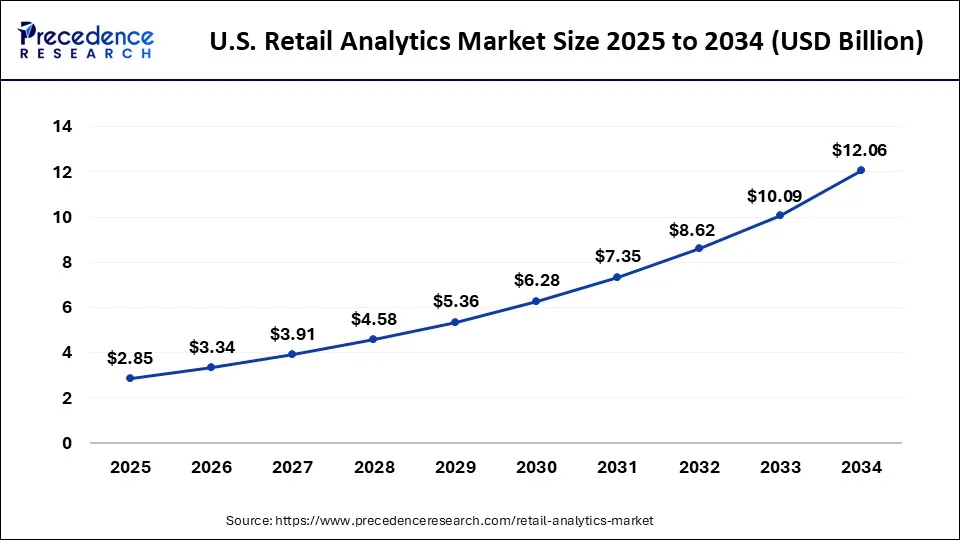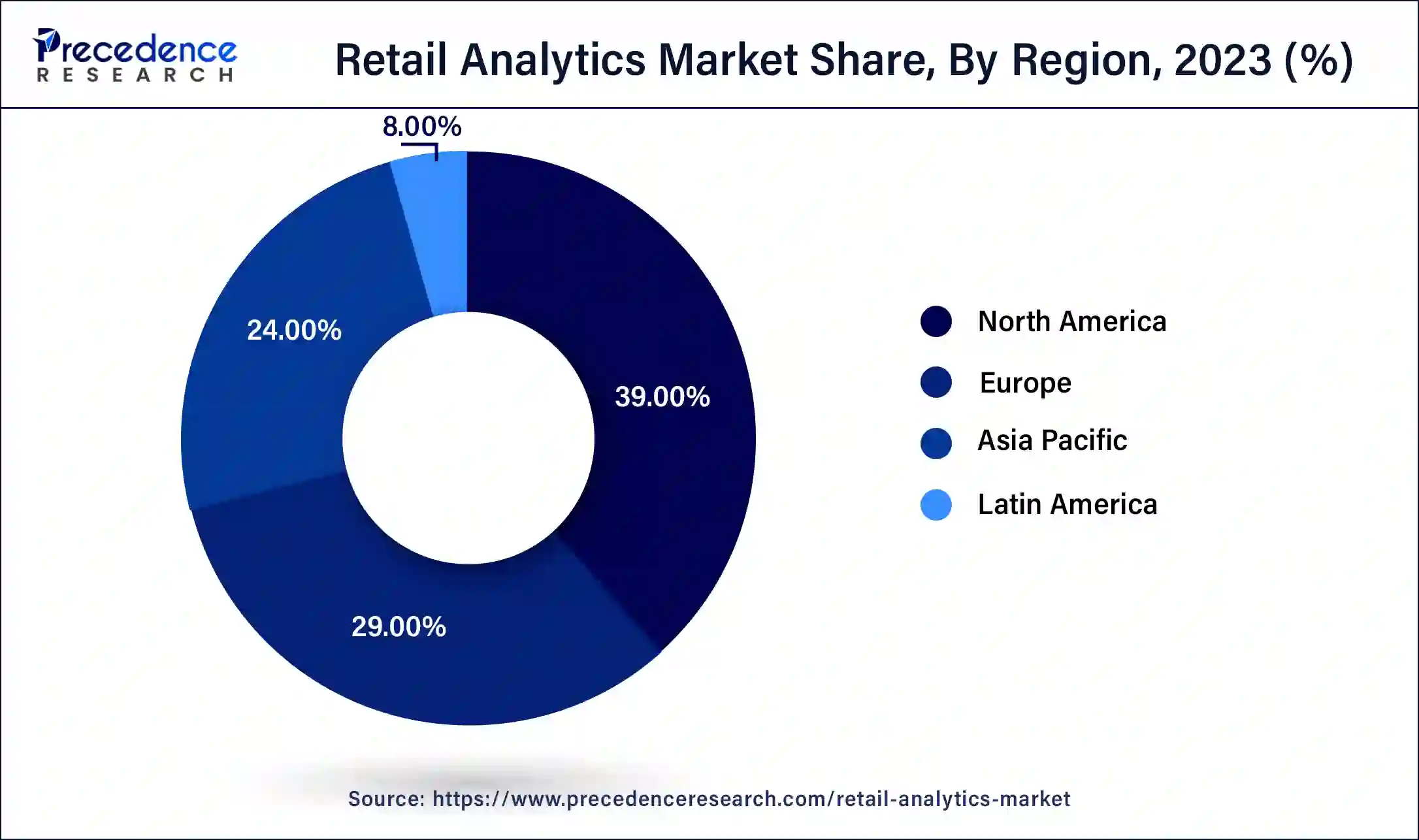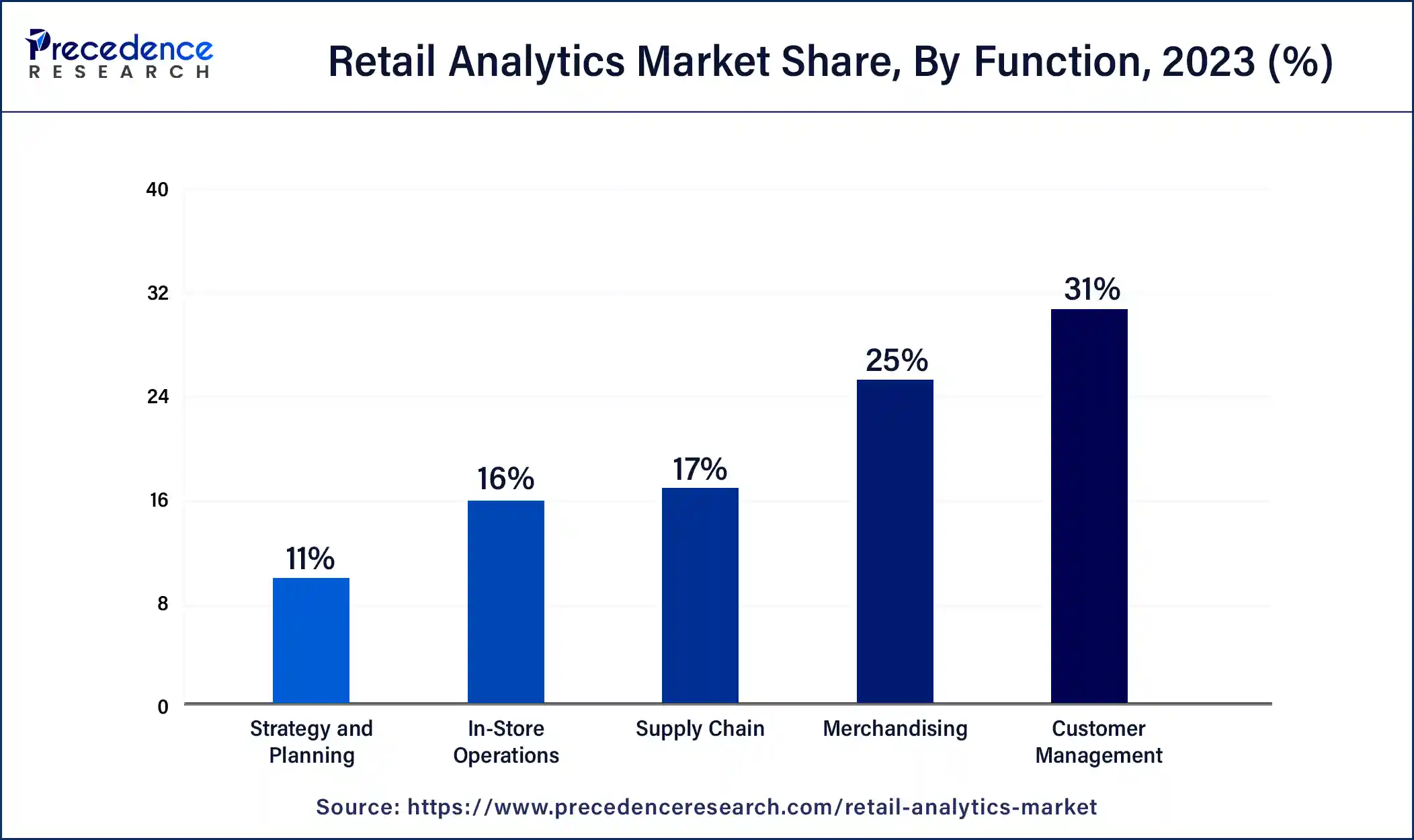July 2024
The global retail analytics market size was USD 7.60 billion in 2023, calculated at USD 8.90 billion in 2024 and is expected to be worth around USD 43.31 billion by 2034. The market is slated to expand at 17.14% CAGR from 2024 to 2034.
The global retail analytics market size is worth around USD 8.90 billion in 2024 and is anticipated to reach around USD 43.31 billion by 2034, growing at a CAGR of 17.14% over the forecast period 2024 to 2034. The North America retail analytics market size reached USD 2.96 billion in 2023. Increasing numbers of E-commerce platforms create a huge amount of data that needs to be managed, and leveraging data-driven insights to expand business is the major factor fuelling the market further. Also, the integration of data analytics and ML in the retail sector is expanding the retail analytics market on a global scale.

The U.S. retail analytics market size was exhibited at USD 2.07 billion in 2023 and is projected to be worth around USD 12.06 billion by 2034, poised to grow at a CAGR of 17.37% from 2024 to 2034.

North America dominated the global retail analytics market in 2023. The growth of this region is majorly due to leading countries like Canada and the U.S. The U.S. accounted for the highest share of the retail analytics market due to the presence of many physical retail stores that focus on the integration of next-generation technologies, changing customer behavior, and the Rising number of investments in retail analytics by major players. Also, the presence and availability of global brands are challenges due to the large competition from local and domestic brands.

Asia Pacific is anticipated to showcase notable growth in the retail analytics market during the forecasted years. The region is proliferating easily due to the retailers in the region using internet connections largely and more frequently, which, in turn, helps marketers adopt analytics tools faster. Analytics helps retailers to understand the market's pattern and consumers' inclination accordingly to strengthen their roots while understanding areas of improvement. Asia Pacific is further proliferating in the retail analytics market due to the evolving countries like India, China, and Japan, where data analytics is frequently used by many marketers in various sectors, including the retail sector.
The retail analytics market is proliferating for various reasons; one of them is that the huge generation of data from different sources is the major factor driving the market's growth. Exponential growth in the e-commerce platform and rising adoption of strategies like omnichannel retail strategy are also the causes of market growth. Retail analytics deals with data analysis with the help of computational techniques to gain insights from the datasets generated by various platforms.
The process of the retail analytics market involves the collection of data, processing it, and analyzing it from various sources, which include sales transactions, records for inventories, consumers' experience, and marketing strategies and their results. By analyzing this precise data, a business can better understand its ability to expand in the market and loopholes to avoid that cause barriers to market expansion, further enhancing the importance of retail analytics.
AI Impact on the retail analytics market
AI has prominently impacted the retail analytics market in many ways. The incorporation of machine learning and data analytics with the help of deep learning algorithms is a current trend in the market. One of the significant applications of AI in the market is the image recognition process, which is revolutionizing the retail market by enhancing the store's ability to capture precise details of real-time visual data, fuelling the growth of the market again.
Image recognition, as the name suggests, uses deep learning algorithms to analyze the images and data, which are visual in nature, gathered from various sources to understand the patterns and gain insights from them. Algorithms are basically trained with huge datasets, enabling them to recognize and categorize objects like products and consumers' faces in the retail analytics market. Object detection and facial recognition are the major components of AI in retail analytics.
| Report Coverage | Details |
| Market Size by 2034 | USD 43.31 Billion |
| Market Size in 2024 | USD 8.90 Billion |
| Market Growth Rate from 2024 to 2034 | CAGR of 17.14% |
| Largest Market | North America |
| Base Year | 2023 |
| Forecast Period | 2024 to 2034 |
| Segments Covered | Deployment, Retail Store, Function, and Regions |
| Regions Covered | North America, Europe, Asia-Pacific, Latin America and Middle East & Africa |
Complexity of generated data
One of the key factors driving the retail analytics market growth is the increasing volume and complexity of data generated by the retail sector. Some of the major sources of data generation in the retail sector include online and offline transactions, customer interactions, supply chains, social media, and more. These data can be used by retailers to get a competitive edge in the market by gathering insights with the help of analytics.
Nearly 56% of consumers expect customized engagement with the help of retailers. It involves analyzing consumers' behavior, choices, preferences, financial ability to purchase the product, willingness to visit the store again or frequently, etc., to create consumer engagement to expand and strengthen their roots in the location where they are operating in the retail analytics market. Such a vast amount of data must be precisely analyzed if they want specific information or to gain business insights. The market can be a game changer as it enables a marketer to reflect on data left by the customers, like purchase history, browsing patterns, and social media interaction, so as to curate personalized recommendations.
Privacy and security concerns
A significant restraining factor for the retail analytics market is the concern about data privacy and its security as it involves the personal data of individuals that get stolen by hackers or unauthorized entities for their benefit and creates a bad reputation for the shops from where data has been leaked. To avoid such a situation, marketers must follow regulatory compliances for the security of the data and privacy standards to keep their reputation and trustworthiness in the market. Since a huge amount of data has been recorded by data analysis tools, hackers get easy access to such sensitive data to manipulate it and threaten the individuals for financial transactions or marketers to hack their entire system.
The trend of e-commerce platforms
A major opportunity that the retail analytics market holds in the generation of E-commerce platforms by many key players owing to the increasing data generation, creating a lucrative option to proliferate the market. The increasing volume and variety of different data have the potential to create several benefits for retail businesses and consumers. Moreover, the surge in digital transformation and the growing trend of e-commerce platforms is likely to expand the adoption of retail analytics solutions and services among organizations.
To increase the conversational rates about specific products that are newly launched, marketers use personal recommendations with the help of data analysis tools to understand people's inclinations and opinions about the products on digital platforms. Retail analytics are made more accessible to users with the help of highly advanced technologies like bi-data analysis, machine learning, and integration of AI, further creating a lucrative opportunity for the proliferation of the retail analytics market.
The cloud segment accounted for the largest share of the retail analytics market in 2023. The growth of this segment is attributed to factors such as real-time assistance that led to data-based insights that proliferated the business further. Thus, cloud-based retail shopping can enhance users' shopping experience.
The on-premises segment is expected to showcase notable growth in the retail analytics market during the forecast period. Conventional on-premises also provides a number of benefits, like mitigating cyberattacks by deploying on-premises retail software, which is the major cause of this segment’s adoption by many enterprises.
The retail chains segment accounted for the largest share of the retail analytics market in 2023. The growth of this segment is due to the retail analytics solutions that help in supply chain management, in-store operations, and inventory management. Major key players in the retail sectors, such as D’mart, Walmart, and others, are enhancing their consumer experience with various methods to strengthen their roots in the market.
The hypermarkets & supermarkets segment is projected to grow at a significant rate in the retail analytics market during the studied period. The growth of this segment is due to the shifting of supermarkets and hypermarkets to adopt data analytics tools to expand their business by analysing real-time data.
The customer management segment dominated the global retail analytics market in 2023. The market is further segmented into merchandising strategy, supply chain, and in-store applications. The evolving consumer need is the major key factor fuelling this segment's demand. Many retailers use a data analytics tool to understand and analyze consumers' preferences for goods and other services they provide so they can expand their business internationally on a larger scale.

The strategy & planning segment will grow rapidly in the global retail analytics market in the upcoming years. Strategy and planning are important aspects to help business optimize their in-store operations and help in fleet management plus logistics operations.
Segments Covered in the Report
By Deployment
By Retail Store
By Function
By Geography
For inquiries regarding discounts, bulk purchases, or customization requests, please contact us at sales@precedenceresearch.com
No cookie-cutter, only authentic analysis – take the 1st step to become a Precedence Research client
July 2024
January 2025
July 2024
July 2024